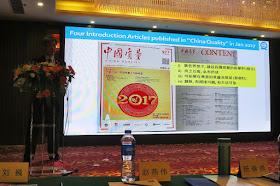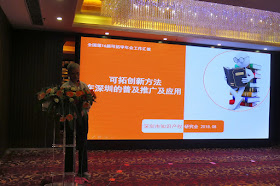The 16th
Annual Meeting of the Extenics (全國第15屆可拓學年會) was organized by Chinese Association for
Artificial Intelligence (CAAI) (中國人工智能學會), undertook by CAAI Extenics Professional
Committee (中國人工智能學會可拓學專業委員會), and Zhuhai Promotion Association of
Science and Technology Innovation (珠海市校企創業創新促進會), Guangzhou Extenics Information
Technology Co., Ltd. (廣州可拓學信息科技有限公司) and 珠海嘉博教育文化有限公司 from 18 to 19 Aug 2018. Minda and I arrived on 17 Aug at 8:00pm for
registration. I took a photo in front of
Extenics poster.
Minda and I met Prof. Cai Wen (蔡文) and Prof. Sun; and then we took a photo for memory.
On 17 Aug 2018 morning, we took a photo before Extenics annual meeting start.
We met
many extenics friends and took some photos too.
Mr. Yin
Hanfan (鄞漢藩) and I
Ms. Luk
(陸碧虹) and
Minda
Prof.
Xingsen Li (李興森) and I
The opening
of the meeting was held on 17 Aug 2018 (Day 1).
In the
beginning, Prof. Yang Chunyan (楊春燕) gave welcome speech and introduced guests.
Prof.
Cai Wen (蔡文) gave an opening speech entitled “Let's Chinese Original Discipine - Extenics
Shining” (讓可拓學進發出原創學科的光芒). Prof. Cai stated Extenics technology
development in AI, Socialization and Internationalization.
Mr. Yang Mu (楊穆) (珠海市科学技术协会副主席) gave guest speech. He was very support Extenics development in Zhuhai and hoped to establish research institute here.
Ms. Liu Hui (劉惠) (珠海市校企創業創新促進會副會長兼秘書長) gave guest speech and she said Extenics needed to promote to all level in China.
Mr.
Huang’s representative
in Beijing Institute of Technology, Zhuhai (北京理工大學珠海學院) gave guest speech that they
were strongly support innovation and creative work. He mentioned to add Extension Innovation
Method into their General Education (通識) course.
Then we
went outside for group photo. I took a selfie.
Prof.
Yang Chunyan worked as leader to lead our queue.
Group
photo was taken.
Then Prof.
Liu Wei (劉巍) (Dalian Maritime University - 大連海事大學) chaired the first keynote
session.
The
first speaker was Prof. Yang Chunyan (楊春燕) and her presentation topic entitled “Extenics
plus AI Research Progress and Future Development” (可拓學+AI的研究概況及未來發展). She said the purposes of Extenics research
were (i) enhancing human intelligence (Extenics + Innovative Education) and
(ii) enhancing machine intelligence to solve contradiction problem (Extenics +
AI = Extension Intelligence).
Then,
Prof. Yang stated the future development of Extenics + AI as follows:
i)
Extension searching engine
ii)
Extension Strategy Generating System (ESGS)
iii)
Solving contradiction problem through App or Platform of ESGS
iv)
New product development through above App or Platform of ESGS
v)
Domain based Extension Data Mining system
vi)
Domain based Extension Intelligent Design system
At the
end, Prof. Yang said Extenics plus AI equal to Extension Intelligence (可拓學+AI=可拓智能) that was an important research
direction.
The
second speaker was Prof. Tian Yingjie (田英傑) (Researcher, Key Laboratory of
Big Data Mining and Knowledge Management, Chinese Academy of Sciences) and his
topic was “Big Data Mining and Extenics” (大數數據挖掘與可拓學). His talk included health big data, data
mining and integrated result.
Firstly,
Prof. Tian introduced the “Sprint Rain” which was leader in M-Health
(Medical-Health) industry and the largest online consultation platform in the
world. It had more than 92 Million users with 500k doctors for 24hr
service.
The
research focused on self-classification, Question-Answer classification, Doctor
Quality Assessment and Doctor Recommendation System. Classification model selected Linear SVM (Support
Vector Machine)
Prof. Tian
introduced Extension Classification (可拓分類) in which employed extenics into SVM in
which blue horizontal arrow means age, green and red arrow indicates high and
low blood pressure level. Finally, he
shared recently publication “Tang Long, Tian Yingjie, Yang Chunyan (2018)
Nonparallel support vector regression and its SMO-type solver. Neural network,
vol. 105, pp.431-446”.
The
third speaker was Mr. Guo Qiang (郭強) who represented Prof. Zou Guangtian (鄒廣天) Harbin Institute of Technology
Faculty Resources (哈爾濱工業大學) to present the topic “Framework and Outlook of Extension Architecture”
(可拓建築學的框架與展望).
Mr. Guo
introduced the Extension Data Mining for Extension Architectural Design
(EapEdm) framework with combined Extenics, Data Mining and Architectural
Programming.
Prof.
Jiang Fan (江帆) (School of Mechanical and Electric Engineering, Guangzhou University)
was the fourth speaker and his topic entitled “A Study based on Solving Problem
Process to Compare Extenics and TRIZ” (基於求解流程的可拓與TRIZ比較研究). Firstly, he introduced TRIZ tools and
Extenics tools.
Then he
briefed the comparison methodology as follows:
i)
Contradiction classification difference
ii)
Foundation theory difference
iii)
Methodology system difference
iv)
Internally difference
Finally,
Prof. Fan used a table as example to demonstrate the different of solving
problem process between Extenics and TRIZ.
He concluded TRIZ had strong in operation with narrow scope and Extenics
had wide scope and more generic on solving contradiction problem. They could be complementary each other.
Prof. Yang
Guowei (楊國為) (Graduate
School, Nanjing Audit University) (南京審計大學) was the fifth speaker and his presentation
named “Constructing the contradiction problem and extension solution strategy through
audit big data intelligent analysis platform” (構建審計大數據智能分析平台的矛盾問題與可拓解決策略).
Firstly,
Prof. Yang briefed some contradiction problems in audit field as follows:
i)
Without protection system for obtaining audit big data
ii)
Without standard, rules and reference
iii)
Need talent who knew among finance business, audit and big data
iv)
Lack small possibility items audit trails
Then he
introduced the extension solution strategy framework to us.
Finally,
he briefed the preliminary thinking for the tender monitoring system under big
data and proposed machine and human integrated decision making.
Prof.
Xingsen Li (李興森) (Institute of Extenics and Innovation Methods, Guangdong University of
Technology) was the sixth speaker and his presentation named “Based Extenics
Intelligent Knowledge Management (IKM)” (基於可拓學的智能知識管理). In the beginning, Prof. Li briefed
our era included internet, IoT, Big Data and AI. The change was too fast to follow traditional
management theory.
Then
Prof. Li mentioned some situations on knowledge management such as managing
knowledge from big data, developing suitable model, establishing framework for
knowledge management, etc. And then he introduced the contradiction problem in
data mining such as low quality data vs high accuracy requirement. After that Prof. Li using framework to
explain solutions for transformation of basic-element, dependent criterion and
universe of discourse.
Lastly,
Prof. Li introduced the whole thinking of Intelligent Knowledge Management that
it was based on Extenics and AI theory and technology through big data
analytics such as filtering, mining, auditing to get useful knowledge and then
for intelligent manipulation. The IKM
system expected to be self-organized, storage, renewal and intelligent
application process. At the end, Prof.
Li used a case study “Customer Lost Alert Extension System” to explain this
concept.
Dr. Ren
shedong (任設東) (College of Mechanical Engineering, Zhejiang University of Technology-浙江工業大學機械工程學院) was the seventh speaker and his
presentation title was “Research on Low Carbon Design of Products Based on
Extension Innovation Method” (基於可拓創新方法的產品低碳設計研究). In
his talk, it introduced low carbon design, extenics based design and integrated
with TRIZ low carbon design. His study
was related to “Made in China 2025” – Green Manufacturing.
Then Dr.
Ren introduced different theory for low carbon design including Akao – QFD,
Altshuller – TRIZ and Cai Wen – Extenics, etc.
The TRIZ and Extenics integrated Innovation Design framework was proposed. It was employed on the innovation design of CNC Cuting Machine (數控裁床)
I was
the eighth speaker represented Hong Kong Society for Quality (HKSQ) to a talk
named “Extenics Internationalization Progress and AI Perspective”. My talk included the review of Extenics
activities from 2016 to 2018 in Hong Kong and International, as well as, Extenics
role in AI Era.
During
review the past activities, the most significant was the 1st World
Summit for Chinese Quality which held in 2016 in Hong Kong. And then China Association of Quality (CAQ)
noticed the Extenics and invited Prof. Cai Wen, Prof. Yang Chunyan and I to
submit total four articles and published in “China Quality” journal.
For
promoting Extenics to international, I presented it in different conference
through HKSQ network such as ASQ WorldPartner and Asia Network for Quality
(ANQ), as well as, International Academy of Quality (IAQ). One of special conferences that I was invited
by Saudi Arabia as one of keynote speakers in their National Quality Conference
in 2017.
At the
end, I shared my idea on Extenics as key part of deep thinking. The core of core in AI was showed in the
circular diagram that AI → Machine
Learning → Deep
Learning → Machine
Thinking → Deep
Thinking (Extenics).
Mr. Yin
Hanfan (鄞漢藩) (General
Secretary, SZIPS) was the ninth speaker and his presentation topic was “Promoting
Extension Innovation Method Application in Shenzhen” (可拓創新方法在深圳的普及推廣及應用). Mr. Yin briefed his methodology which
employed extension resource as follows.
i)
Utilizing different resource including government, professional alliance
and incubators for promoting Extension Innovation Method
ii)
Proactive joining Extencis training course
iii)
Formulating industrial base and market-oriented, as well as, government
– academic – education and industry collaboration model
After
that Mr. Yin introduced Extenics training for young people from primary school
to secondary school and then to high school.
Finally, Mr. Yin shared their simplification of last step “Selection” to calculate the prioritization of innovative idea from students.
Ms. Liu Hui
(劉惠) (珠海市校企創業創新促進會副會長兼秘書長) was the tenth speaker and her
topic entitled “Extension Innovation Method Popularization and Promotion in Zhuhai
& Macau” (可拓創新方法在珠海澳門的普及推廣).
Firstly, Ms. Liu said Zhuhai and Macau like a one city with two
systems.
Then she
mentioned Prof. Cai Wen had provided 3 days training course of Extension
Innovation Method from 26th to 28th July 2017.
Ms. Liu
also mentioned significant achievement in Macau by Dr. Lin Chang (林暢) (Chairman, Macau Quality
Management Association (MQMA)) that Macau government funding supported citizen
to learn Extenics.
After
tea break, Prof. Zhao Yanwei (趙燕偉) (Zhejiang University of Technology) chaired the last session.
The
eleventh speaker was Mr. Li Henghui (李恆輝) (深圳市中創創業研究院執行院長) and his presentation entitled “The
Correlation between Extenics and Mao Zedong Thought in Resolving Contradictions
- A Case Study of Sino-US Trade War” (可拓學與毛澤東思想在解決矛盾問題上的相關性 - 以中美貿易戰為例).
Firstly, Mr. Li said Sino-US trade war was protracted war and introduced
Mao Zedong’s discussion of protracted war.
Then Mr.
Li used basic-element theory to describe Sino-US Trade War. After that he
proposed 3 stages from Strategic Protection to Strategic Holding and to
Strategic Counterattack.
The
twelfth speaker was Mr. Zhao Yongjun (趙擁軍) (珠海邁克芬科技有限公司總經理) and his topic named
“Application of Extenics in Technology and Innovation” (可拓學在科技創新中的應用). Firstly, he introduced his company and their
understanding on Extenics. His company
established in 2013 in Beijing.
One of
their products was Space Suit. They
employed Extenics in technology innovation included Thinking Method Innovation,
Extension of Technology Depth, Technology Wide and Application.
The
thirtieth speaker was Prof. Zhang Zhan (張展) (Beijing Level5 Data Technology
Co., Ltd., Chinese Academy of Science), Prof. Xingsen Li (李興森) represented him to present the
topic entitled “The Extension Model of Big Data Technology Enhancing Enterprise
Value” (大數據技術助力企業價值提升的可拓模式).
Firstly,
Prof. Li briefed some difficulties of big data included non-accuracy data and
less awareness of data accuracy by leaders. He said Prof. Zhang Zhan proposed to
use Extenics to solve these contradictions.
Finally,
Prof. Li mentioned some cases including Pentode Score for credit, Precision
Sales, nuclear plant, life insurance, etc.
The last
speaker was Mr. Dong Baojun (董寶軍) (浙江弘日寶璽創新投資管理有限公司合伙人) and his presentation topic was “Application
of Extension Method in Financial Investment Analysis” (可拓方法在金融投資分析中的應用). Mr. Dong used conjugate analysis for
different companies including Haier, Alibaba, ofo, etc.
Reference:
Research
Institute of Extenics and Innovation Methods, GDUT (廣東工業大學可拓學與創新方法研究所) - http://extenics.gdut.edu.cn/info/1041/1302.htm
Previous Extenics Annual
Meeting activities:
20160810:
Pre-Extenics Annual Meeting (全國第15屆可拓學年會) – Extenics Level 1 Exam - https://qualityalchemist.blogspot.com/2016/08/pre-extenics-annual-meeting-15-extenics.html
20160811:
The 15th Annual Meeting of the Extenics (全國第15屆可拓學年會) – Day 1 - https://qualityalchemist.blogspot.com/2016/08/the-15th-annual-meeting-of-extenics-15.html
20160812:
The 15th Annual Meeting of the Extenics (全國第15屆可拓學年會) – Day 2 - https://qualityalchemist.blogspot.com/2016/08/the-15th-annual-meeting-of-extenics-15_12.html




















































沒有留言:
發佈留言